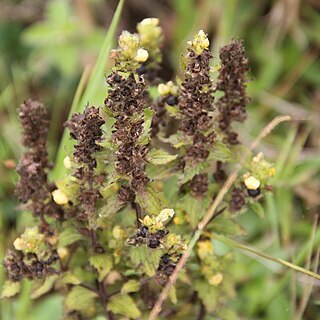Erect, wiry herbs parasitizing the roots of other plants. Leaves opposite or alternate, crenate to toothed, often scabrous, subsessile or petiolate, often appear-ing 3-nerved. Inflorescences solitary flowers in the upper leaf axils, sometimes appearing racemose; pedicels with a narrow bract near the apex. Flowers with the calyx campanulate, the 5 short lobes alike; corolla campanulate, variously exserted; stamens 4, the filaments glabrous or bearded, the anthers sometimes mucronate. Fruiting calyx sometimes accrescent.
Corolla thin, early marcescent, persistent in calyx, surrounding capsule, narrowly campanulate, slightly oblique, longer than calyx; lobes rounded, spreading to slightly recurved.
Flowers solitary in axils of upper leaves or leaflike bracts, sessile or shortly pedicellate, yellow to orange with brown to reddish-purple veins, bibracteolate.
Filaments all bearded, or only the two larger ones bearded or all glabrous, bearding may be overall or in lower half or upper half or just below anthers.
Annual or perennial herbs, usually erect, simple or branched, usually hispid, root parasites, turning black when dry.
Calyx campanulate, 5-lobed, 10-nerved, calyx not enlarging in fruit; lobes subequal, usually subequalling tube.
Leaves opposite or alternate, sessile or shortly petiolate, of ten very small, scale-like, entire or toothed.
Ovary glabrous; style clavate above middle, recurved, included with stamens in persistent corolla.
Stamens 4, didynamous, at times subequal, attached towards base of corolla tube, included.
Anthers coherent or connivent in pairs, thecae equal or unequal, apiculate or not.
Seeds very numerous, linear or clavate, straight or curved, slender, truncate.
Capsule globose to broadly ovoid, included, loculicidal.

